Bharat Ratna facts for kids
Quick facts for kids Bharat Ratna |
|
|---|---|
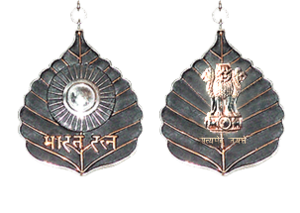 |
|
| Awarded for | Highest Civilian Award of the Republic of India |
| Presented by | |
| Country | |
The Bharat Ratna (which means "Jewel of India") is the highest award a civilian can receive in India. It was started on January 2, 1954. This special award is given to people who have done "exceptional service" or shown "performance of the highest order." It doesn't matter what their race, job, position, or gender is.
When the award first began, it was only for achievements in arts, literature, science, and public service. But in December 2011, the rules changed. Now, it can be given for achievements in "any field of human effort." The Prime Minister of India suggests names for the award to the President of India. Those who receive the award get a certificate signed by the President. They also get a medal shaped like a peepal leaf. Bharat Ratna winners are ranked seventh in India's official order of importance.
The first people to receive the Bharat Ratna in 1954 were C. Rajagopalachari, Sarvepalli Radhakrishnan, and C. V. Raman. Since then, 53 people have received the award. This includes 18 people who received it posthumously. This means they received it after they had passed away. The rules were changed in 1966 to allow for posthumous awards. Lal Bahadur Shastri was the first person to receive it after his death.
In 2014, the famous cricketer Sachin Tendulkar became the youngest person to get the award. He was 40 years old at the time. The oldest person to receive it was social reformer Dhondo Keshav Karve. He was honored on his 100th birthday. Most winners are Indian citizens. However, Mother Teresa, who became an Indian citizen, also received it. Two non-Indians, Abdul Ghaffar Khan and Nelson Mandela, have also been honored.
The Bharat Ratna award was stopped twice for a short time. The first time was from July 1977 to January 1980. This happened when the government changed. It was stopped again from August 1992 to December 1995. This was because some people questioned if the awards were allowed by the country's laws. In 1992, there was a plan to give the award to Subhas Chandra Bose after his death. But some people did not believe he had died. So, the award for him was canceled. This is the only time an award was announced but not given.
Contents
History of the Award
On January 2, 1954, the Indian government announced two new civilian awards. The highest was the Bharat Ratna, meaning "Jewel of India." Below it was the Padma Vibhushan, which had three levels.
On January 15, 1955, the Padma Vibhushan was changed. It became three separate awards: the Padma Vibhushan, the Padma Bhushan, and the Padma Shri. These are still important awards today.
When the Award Was Paused
The Bharat Ratna was paused two times. The first time was on July 13, 1977. This happened when Morarji Desai became the Prime Minister. He stopped all personal civilian awards. But on January 25, 1980, when Indira Gandhi became Prime Minister again, the awards were brought back.
The award was paused a second time in mid-1992. This was because some people went to court. They questioned if the awards were allowed by the Indian Constitution. The Supreme Court of India brought the awards back in December 1995.
Who Can Receive the Award?
There are no strict rules that only Indian citizens can receive the Bharat Ratna. Mother Teresa, who became an Indian citizen, received it in 1980. Two people who were not Indian citizens also received it. They were Abdul Ghaffar Khan from Pakistan in 1987 and Nelson Mandela from South Africa in 1990.
Sachin Tendulkar, a famous cricketer, received the award when he was 40 years old. He was the youngest person and the first sportsperson to get this honor. Dhondo Keshav Karve was the oldest living person to receive it. He was given the award on his 100th birthday in 1958. As of 2024, 53 people have received the award. Fifteen of these awards were given posthumously.
Rules for the Award
The Bharat Ratna is given for "exceptional service or performance of the highest order." It is given without looking at a person's race, job, position, or gender. In 1954, the award was only for arts, literature, science, and public service. But in December 2011, the rules were changed. Now, it can be given for "any field of human effort." The original rules from 1954 did not allow awards after a person's death. However, this rule was changed in 1966. Lal Bahadur Shastri was the first person to receive it posthumously in 1966.
There is no official way to suggest names for the award. Only the Prime Minister can recommend names to the President. The person who receives the award gets a certificate signed by the President. They also get a medal. There is no money given with the award.
Winners of the Bharat Ratna can use phrases like "Awarded Bharat Ratna by the President" or "Recipient of Bharat Ratna Award." They are placed seventh in the official Indian order of precedence. This means they are considered very important in official events. When an award is given, it is officially announced in The Gazette of India. This is a government publication. If an award is taken back or given back, it is also recorded in the Gazette. If an award is taken back, the person must return their medal. Their name is also removed from the official list.
What the Medal Looks Like
The first Bharat Ratna medal in 1954 was a gold circle. It had a picture of the sun in the middle. The words "Bharat Ratna" were written in Hindi script on the top edge. On the back, it had the State Emblem of India and the national motto, "Satyameva Jayate" (meaning "Truth alone triumphs").
A year later, the design was changed. The medal now looks like a peepal leaf. It is about 2.3 inches long and 1.8 inches wide. It has a platinum rim. The sun design on the front is also made of platinum. The words "Bharat Ratna" and the emblem on the back stayed the same as the 1954 design. A white ribbon, about 2 inches wide, is attached to the medal. This allows it to be worn around the neck. In 1957, the silver-colored parts were changed to a shiny bronze. The medals are made at the Alipore Mint in Kolkata.
Benefits for Award Winners
People who receive the Bharat Ratna cannot use it as a title before or after their name. However, they can say they were "Awarded Bharat Ratna by the President" or are a "Recipient of Bharat Ratna Award." The award does not come with money. But it does include some special benefits:
- The medal and a smaller version of it.
- A certificate signed by the President of India.
- They are treated as state guests by state governments when they travel within a state.
- Indian offices in other countries are asked to help them if needed.
- They can get a diplomatic passport.
- They are placed seventh in the Indian order of precedence.
- They get a special discount on flights with Air India.
Public Requests for the Award
Even though only the Prime Minister can recommend names for the Bharat Ratna, many political parties have publicly asked for their leaders to receive the award. For example, in 2008, L. K. Advani asked for Atal Bihari Vajpayee to get the award. Other parties also asked for their leaders like Jyoti Basu, N. T. Rama Rao, Kanshi Ram, and Parkash Singh Badal. In 2015, the Shiv Sena party asked for the award for Vinayak Damodar Savarkar, an independence activist.
At first, sportspeople could not get the award. But the rules changed in December 2011 to include "any field of human effort." After this, many sportspeople were considered. These included hockey player Dhyan Chand and chess champion Viswanathan Anand. In 2013, the government recommended Dhyan Chand again. However, in November 2013, cricketer Sachin Tendulkar became the first sportsperson to receive the honor. This decision caused some discussion.
In 2012, a court case was filed in Karnataka. It asked the court to tell the government to give the Bharat Ratna to Mahatma Gandhi. In 2014, the court said that deciding who gets the award is up to the government's highest authority. It is not something the court can decide.
List of Bharat Ratna Recipients
| + Naturalised citizen recipient | * Non-citizen recipient | # Posthumous recipient |
| Year | Image | Recipient | State / Country | Life span | Notes |
|---|---|---|---|---|---|
| 1954 | 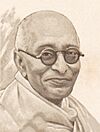 |
C. Rajagopalachari | Tamil Nadu | 1878–1972 | Rajagopalachari was an independence activist. He was the last Governor-General of India (1948–50). He also served as the first governor of West Bengal and as chief minister of Tamil Nadu. |
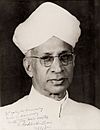 |
Sarvepalli Radhakrishnan | Tamil Nadu | 1888–1975 | Radhakrishnan was the first Vice-President of India (1952–62). He later became the second President of India (1962–67). His birthday, September 5, is celebrated as Teachers' Day in India. | |
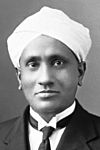 |
C. V. Raman | Tamil Nadu | 1888–1970 | Raman was a physicist famous for his work on light scattering. He discovered Raman scattering and Raman spectroscopy. He won the Nobel Prize in Physics in 1930. | |
| 1955 | 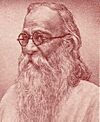 |
Bhagwan Das | Uttar Pradesh | 1869–1958 | Bhagwan Das was an independence activist and educationist. He helped start Mahatma Gandhi Kashi Vidyapith and Banaras Hindu University. |
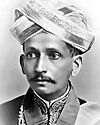 |
M. Visvesvaraya | Karnataka | 1861–1962 | Visvesvaraya was a civil engineer and statesman. He was the 19th Diwan of Mysore (1912–1918). His birthday, September 15, is celebrated as Engineer's Day in India. | |
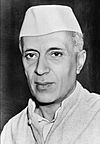 |
Jawaharlal Nehru | Uttar Pradesh | 1889–1964 | Nehru was an independence activist and politician. He was the first and longest-serving Prime Minister of India (1947–1964). | |
| 1957 | 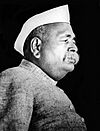 |
Govind Ballabh Pant | Uttar Pradesh | 1887–1961 | Pant was an independence activist and politician. He served as the first chief minister of Uttar Pradesh (1950–1954). He was also the Union Home Minister (1955–1961). |
| 1958 | 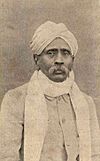 |
Dhondo Keshav Karve | Maharashtra | 1858–1962 | Karve was a social reformer and educator. He worked for women's education and the remarriage of Hindu widows. He started the SNDT Women's University in 1916. |
| 1961 |  |
Bidhan Chandra Roy | West Bengal | 1882–1962 | Roy was a physician, politician, and educationist. He was the second Chief Minister of West Bengal (1948–1962). He is known as the "Maker of Modern West Bengal." His birthday, July 1, is National Doctors' Day in India. |
 |
Purushottam Das Tandon | Uttar Pradesh | 1882–1962 | Tandon was an independence activist and politician. He was the speaker of the Uttar Pradesh Legislative Assembly (1937–1950). He worked to make Hindi an official language. | |
| 1962 | 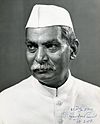 |
Rajendra Prasad | Bihar | 1884–1963 | Prasad was an independence activist and lawyer. He worked with Mahatma Gandhi in the Champaran Satyagraha. He was the first President of India (1950–1962). |
| 1963 | 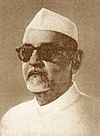 |
Zakir Husain | Telangana | 1897–1969 | Husain was an independence activist and philosopher. He was the second Vice-President of India (1962–1967). He later became the third President of India (1967–1969). |
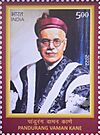 |
Pandurang Vaman Kane | Maharashtra | 1880–1972 | Kane was a scholar of Indian history and Sanskrit. He is known for his five-volume work, History of Dharmaśāstra. | |
| 1966 | 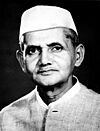 |
Lal Bahadur Shastri# | Uttar Pradesh | 1904–1966 | Shastri was an independence activist. He is known for his slogan "Jai Jawan Jai Kisan" ("Hail to the Soldier, hail to the Farmer"). He was the second Prime Minister of India (1964–1966). |
| 1971 | 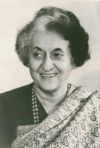 |
Indira Gandhi | Uttar Pradesh | 1917–1984 | Indira Gandhi was the Prime Minister of India (1966–1977 and 1980–1984). She is known as the "Iron Lady of India." She led India during the Indo-Pakistani War of 1971. |
| 1975 | 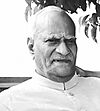 |
V. V. Giri | Odisha | 1894–1980 | Giri was an independence activist. He helped organize trade unions. He became the fourth President of India (1969–1974). |
| 1976 | 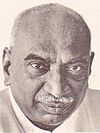 |
K. Kamaraj# | Tamil Nadu | 1903–1975 | Kamaraj was an independence activist and politician. He was the chief minister of Tamil Nadu for over nine years (1954–1963). He was known as the "King Maker." |
| 1980 |  |
Mother Teresa + | West Bengal (b.Skopje, North Macedonia) |
1910–1997 | Mother Teresa was a Catholic nun. She founded the Missionaries of Charity. This group helps sick people. She won the Nobel Peace Prize in 1979 for her humanitarian work. |
| 1983 |  |
Vinoba Bhave# | Maharashtra | 1895–1982 | Bhave was an independence activist and social reformer. He was a friend of Mahatma Gandhi. He is known for his Bhoodan movement. |
| 1987 | 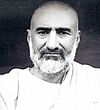 |
Abdul Ghaffar Khan* | Pakistan | 1890–1988 | Khan was an independence activist and a follower of Mahatma Gandhi. He worked for unity between Hindus and Muslims. He was known as "Frontier Gandhi." |
| 1988 | 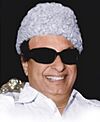 |
M. G. Ramachandran# | Tamil Nadu | 1917–1987 | M. G. Ramachandran (M.G.R.) was an actor and politician. He was the chief minister of Tamil Nadu for over ten years (1977–1987). |
| 1990 | 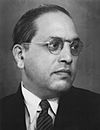 |
B. R. Ambedkar# | Madhya Pradesh | 1891–1956 | Ambedkar was a social reformer and lawyer. He led the committee that wrote the Indian Constitution. He worked against social discrimination and the caste system in India. |
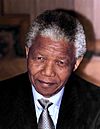 |
Nelson Mandela* | South Africa | 1918–2013 | Mandela led the Anti-Apartheid Movement in South Africa. He later became the President of South Africa (1994–1999). He won the Nobel Peace Prize in 1993. | |
| 1991 |  |
Rajiv Gandhi# | Uttar Pradesh | 1944–1991 | Rajiv Gandhi was a pilot who became a politician. He served as the sixth Prime Minister of India (1984–1989). |
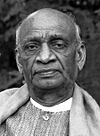 |
Vallabhbhai Patel# | Gujarat | 1875–1950 | Patel was an independence activist. He was the first Deputy Prime Minister of India (1947–1950). He was known as the "Iron Man of India." | |
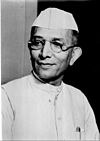 |
Morarji Desai | Gujarat | 1896–1995 | Desai was an independence activist and politician. He was the fourth Prime Minister of India (1977–1979). He was the first Prime Minister not from the Indian National Congress. | |
| 1992 | 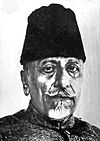 |
Abul Kalam Azad# | West Bengal | 1888–1958 | Azad was an independence activist and politician. He was the first education minister of India. His birthday, November 11, is National Education Day in India. |
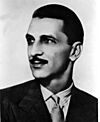 |
J. R. D. Tata | Maharashtra | 1904–1993 | Tata was an industrialist and aviation pioneer. He was the chairman of the Tata Group. He founded many educational and research institutes. | |
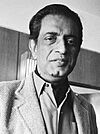 |
Satyajit Ray | West Bengal | 1922–1992 | Ray was a film director. He directed his first film Pather Panchali in 1955. He helped bring Indian cinema to world attention. | |
| 1997 | 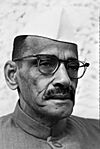 |
Gulzarilal Nanda | Punjab | 1898–1998 | Nanda was an independence activist and politician. He served as interim Prime Minister of India in 1964 and 1966. |
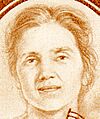 |
Aruna Asaf Ali# | West Bengal | 1909–1996 | Ali was an independence activist. She is known for raising the Indian flag during the Quit India Movement in 1942. She was Delhi's first mayor in 1958. | |
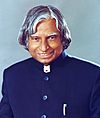 |
A. P. J. Abdul Kalam | Tamil Nadu | 1931–2015 | Kalam was an aerospace scientist. He later became the eleventh President of India (2002–2007). He helped develop India's first satellite launch vehicle. | |
| 1998 | 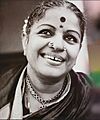 |
M. S. Subbulakshmi | Tamil Nadu | 1916–2004 | Subbulakshmi was a Carnatic classical vocalist. She was known for her songs and religious chants. She was the first Indian musician to receive the Ramon Magsaysay award. |
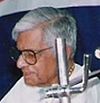 |
C. Subramaniam | Tamil Nadu | 1910–2000 | Subramaniam was an independence activist and politician. He was the minister of agriculture (1964–1966). He is known for his work in the Green Revolution in India. | |
| 1999 | 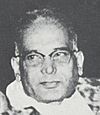 |
Jayaprakash Narayan# | Bihar | 1902–1979 | Narayan was an independence activist and social reformer. He was called "Loknayak" ("People's Leader"). He is known for the Total Revolution Movement in the 1970s. |
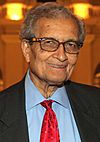 |
Amartya Sen | West Bengal | b. 1933 | Sen is an economist. He won the Nobel memorial prize in economic sciences in 1998. | |
 |
Gopinath Bordoloi# | Assam | 1890–1950 | Bordoloi was an independence activist and politician. He was the first chief minister of Assam (1946–1950). He helped keep Assam united with India. | |
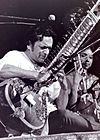 |
Ravi Shankar | Uttar Pradesh | 1920–2012 | Ravi Shankar was a musician and sitar player. He won four Grammy Awards. He is known for bringing Hindustani classical music to the world. | |
| 2001 | 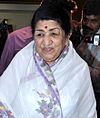 |
Lata Mangeshkar | Maharashtra | 1929–2022 | Mangeshkar was a playback singer. She was known as the "nightingale of India." She sang in over 36 languages. |
 |
Bismillah Khan | Bihar | 1916–2006 | Khan was a Hindustani classical shehnai player. He played the instrument for over eight decades. He helped make the shehnai famous in Indian music. | |
| 2009 | 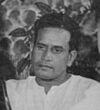 |
Bhimsen Joshi | Karnataka | 1922–2011 | Joshi was a Hindustani classical vocalist. He was known for his Khyal style of singing. |
| 2014 |  |
C. N. R. Rao | Karnataka | b. 1934 | Rao is a chemist and scientist. He specializes in solid state chemistry. He has written many research papers and books. |
 |
Sachin Tendulkar | Maharashtra | b. 1973 | Tendulkar is a cricketer. He is considered one of the greatest batters of all time. He played over 600 international matches and holds many cricket records. | |
| 2015 |  |
Atal Bihari Vajpayee | Madhya Pradesh | 1924–2018 | Vajpayee was a politician. He served as the Prime Minister of India three times (1996, 1998, and 1999–2004). He was a member of parliament for over four decades. |
 |
Madan Mohan Malaviya# | Uttar Pradesh | 1861–1946 | Malaviya was a scholar and educational reformer. He founded the Banaras Hindu University. He was also the President of the Indian National Congress four times. | |
| 2019 |  |
Pranab Mukherjee | West Bengal | 1935–2020 | Mukherjee was a politician. He served as the 13th President of India (2012–2017). He held many important government positions. |
 |
Bhupen Hazarika# | Assam | 1926–2011 | Hazarika was a playback singer, musician, poet, and filmmaker. He was known as Sudhakantha. His songs were about justice and peace. | |
 |
Nanaji Deshmukh# | Maharashtra | 1916–2010 | Deshmukh was a social activist and politician. He worked in education, health, and rural self-reliance. | |
| 2024 |  |
Karpoori Thakur# | Bihar | 1924–1988 | Thakur was a politician. He served two terms as the 11th Chief Minister of Bihar (1970–1971, 1977–1979). He introduced a reservation policy for state government jobs. |
 |
L. K. Advani | Delhi | b. 1927 | Advani is a politician. He served as the 7th Deputy Prime Minister of India (2002–2004). He helped found the Bharatiya Janata Party. | |
 |
P. V. Narasimha Rao# | Telangana | 1921–2004 | Narasimha Rao was a lawyer and politician. He served as the 9th Prime Minister of India (1991–1996). He was the first Prime Minister from South India. He is known for bringing economic reforms to India. | |
 |
Charan Singh# | Uttar Pradesh | 1902–1987 | Charan Singh was an Indian politician and independence activist. He served as the 5th Prime Minister (1979–1980). He is known as the "Champion of India's peasants." | |
 |
M. S. Swaminathan# | Tamil Nadu | 1925–2023 | Swaminathan was an Indian agronomist and geneticist. He was a global leader in the Green Revolution. He helped introduce high-yielding varieties of wheat and rice in India. |
See also
 In Spanish: Premio Bharat Ratna para niños
In Spanish: Premio Bharat Ratna para niños
- Orders, decorations, and medals of India
- Padma Vibhushan
- Padma Bhushan
- Padma Shri


